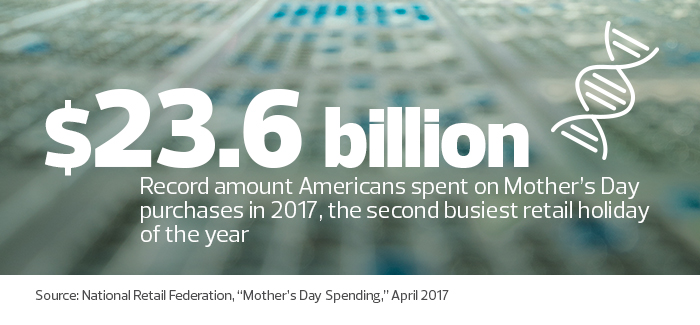The Holiday Data Processing Crush Approaches — Here's How to Handle It
Family-focused holidays — think Mother’s Day, Father’s Day and the festive season from early November through New Year’s — are good for business at Gene By Gene, a genealogical and clinical genetic testing company in Houston.
DNA analysis, it turns out, is the perfect gift for a loved one who has taken up the wildly popular hobby of genealogy or who has a passing interest in family history.
Those seasonal peaks, however, test the company’s IT resources, says Wence Gutierrez, senior systems engineer at Gene By Gene. The company meets the challenge with a strategy built around Oracle virtualization technology, with a boost from Barracuda load balancing.
“We have our own labs and process customers’ samples ourselves, so we’re always generating and storing a lot of data,” Gutierrez says. “As a busy time approaches, we simply spin up more virtual machines. Because we’re growing, we usually just shift the resources to other projects after the rush.”
SIGN UP: Get more news from the BizTech newsletter in your inbox every two weeks!
Cloud Makes Small Businesses More Efficient
By grounding its strategy to cope with spikes and lulls in its own data center, Gene By Gene is bucking a trend.
Small to medium-sized businesses have been relatively quick to move to cloud services to deal with seasonal business fluctuations, primarily because of cost and the burden on staff required to maintain infrastructure, says Andre Kindness, a principal analyst at Forrester Research.
The development of Internet of Things technologies that ease seasonal pressures on inventory monitoring and order tracking will reinforce that cloudward trend by accelerating the need for on-demand services to process and store surging data streams, he says.

As companies, particularly small businesses, have expanded their use of virtualization and cloud, that has simultaneously extended the concept of load balancing. It now includes not just how companies manage resources across corporate systems on-premises, but also how they tap virtualized resources and cloud services to redistribute work in near real time.
For companies that keep most, or all, of their IT resources on-premises, over-provisioning is one of the most common mistakes, Kindness says.
“They just buy too much,” he says. “They go through a very busy, difficult time for IT where their resources are stretched thin. Then they have lots of money, and they overspend.”
Companies that have to deal with business fluctuations should consider cloud services for any function that makes sense for their business models, Kindness says. “Remember to take a close look at your processes and how you serve your customers before you make changes.”
Once a company has settled on its mix of on-premises and cloud resources, it then can apply traditional load-balancing technology alongside cloud load-balancing tactics to create a highly flexible environment that can scale up and down with seasonal workload and retail spikes.
Spin Up Virtual Machines When Needed
Gene By Gene has moved to some cloud services for its customer-facing internet applications, but for the sake of efficiency and better customer service, it keeps back-end processing in-house, Gutierrez says.
Using an Oracle Private Cloud Appliance (PCA) with a Xen hypervisor as its virtualization platform, Gene By Gene can ramp up processing power quickly by generating additional virtual machines, which can be disabled or shifted to other functions later.
The PCA provides its own internal network infrastructure, with InfiniBand links to Oracle storage drives that provide high availability without the necessity of a separate storage area network, Gutierrez says. In anticipation of peaks, Gene By Gene sometimes adds Oracle X6 server hardware, which is repurposed in quieter times to new projects.
Load Balancing Improves Application Performance
The Barracuda Load Balancer ADC is another critical element in the company’s peak-performance strategy, says Gene By Gene Senior Systems Engineer Mitch Forrest.
The appliance provides a high-performance application delivery platform for Gene By Gene’s website. By offloading Secure Sockets Layer transactions from the site, the Load Balancer ADC frees up resources for applications and dramatically improves management of SSL certificates, Forrest says. It has also significantly upgraded load balancing for the website and boosted Gene By Gene’s firewall protection.
“We chose Barracuda because of all the things it does and its flexibility when we need to adjust quickly,” Forrest says. “It’s also supported by major cloud platforms, should we decide to go in that direction.”

That decision is always under consideration at Gene By Gene. In addition to seasonal peaks, any time a new genetic marker is discovered, that information is integrated into customer results. Any extra demand on computing resources comes on top of the 3 to 4 terabytes of data the company generates daily.
For now, moving that volume of data to and from the cloud would require enormous bandwidth — and would be slower than processing data on-premises.
“Our approach could change as we keep up with our growth, as well as meet seasonal spurts,” Gutierrez says. “We have new products all the time that bring us new customers and keep old customers interested. We’ll keep evaluating how best to serve them.”
Prepare for the Data Deluge Around the Holidays
The November-December rush at Made In Washington, a purveyor of artisanal gifts and food in Anacortes, Wash., makes Gene By Gene’s seasonal peak seem light. The IT team spends nine months of every year preparing its systems to process the 82 percent of the company’s business that takes place during that two-month window, says Mike Phillips. Phillips is IT director for SeaBear, the parent company of Made In Washington’s e-commerce site and brick-and-mortar stores, as well as SeaBear.com, which sells salmon and other fish products to restaurants.
“After the season is over, we do a thorough review of the pain points, from our call center to our distribution systems, and then we start addressing those issues along with our other projects to get ready for the next holiday,” Phillips says. “Our biggest problems are usually how to handle our web traffic and the volume to our call center, which goes from four or five people on staff to 50 during the rush.”
Make Your Infrastructure Spike-Ready
The company has used cloud services but moved away from them last year after installing a 1-gigabit-per-second, looped-fiber connection and deploying VMware with high availability. This setup increased flexibility and visibility into operations, and reduced costs, Phillips says.
Virtualization let SeaBear consolidate 30 physical servers down to eight Dell rack servers. Scaling up on the fly in response to unexpected spikes is simply a matter of generating additional VMs, as the IT staff does in advance for planned promotions and the holiday season.
“We’ve saved money hosting our sites ourselves, and it’s so much easier to keep an eye on the network internally during all seasons,” Phillips says. “You lose the redundancy of the cloud, for sure. But with looped fiber, battery backup and VMware — where, if a server crashes, another one will automatically pick up the load — it makes sense to stay in-house.”
Planning ahead for both good and bad exigencies is the key to navigating peak times, he says. “Don’t assume that you have the capacity you need with what you have,” Phillips points out. “Systems can fail. But much better, there will be a lot more traffic if you exceed sales goals.”








